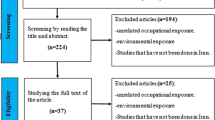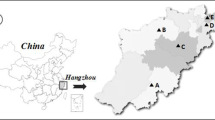Abstract
Welding fumes have an important role to create the adverse health effects. So, the aim of this study was to use of multiple occupational health risk assessment models for metal fumes in welding process. This cross-sectional study was conducted among welding workers. Sampling of heavy metals such as Sn, Zn, Al, Fe, Cd, Pb, Cu, Mn, Ni, Cr, and As was provided based on the National Institute for Occupational Safety and Health (NIOSH) method 7300 and analyzed by inductively coupled plasma mass spectroscopy (ICP-MS). Risk assessment was managed by four methods including Malaysia’s method, Control of Substances Hazardous to Health Essentials (COSHH model), Chinese OHRA standard (GBZ/T 298–2017), and EPA method. Also, Monte Carlo simulation was used to examine the uncertainties by using the Crystal Ball tool. To compare the models, the risk levels of each model were converted into the risk ratio and the SPSS 22.0 software was used to the statistical analysis. The consistency of the two occupational health risk assessment models was examined by Cohen’s Kappa. Risk ration was the highest level for Cr (VI) fumes in all models. Also, carcinogenic risk was unacceptable for all examined fumes. Moreover, non-carcinogenic risk was the highest (HI > 1) for As fumes. Mont Carlo simulations suggested that exposure time (ET) had a significant effect on the risk. Also, there was a good consistency between Malaysia method/GBZ/T 298–2017 and COSHH model/GBZ/T 298–2017. Therefore, it is recommended that the engineering and administrative controls should be provided to reduce exposure.



Similar content being viewed by others
Data Availability
All data generated or analyzed during this study are included in this published article. Also, readers can seek published preprint in Research Square with https://doi.org/10.21203/rs.3.rs-2476293/v2 [48].
References
Hariri A et al (2018) Heavy metals found in the breathing zone, toenails and lung function of welders working in an air-conditioned welding workplace. Int J Occup Saf Ergon 4:646–651
Mehrifar Y, Zamanian Z, Pirami H (2019) Respiratory exposure to toxic gases and metal fumes produced by welding processes and pulmonary function tests. Int J Occup Environ Med 1:40
Li H et al (2015) Oxidative stress, telomere shortening, and DNA methylation in relation to low-to-moderate occupational exposure to welding fumes. Environ Mol Mutagen 8:684–693
Motamedrezaei O et al. (2022) An investigation of lead concentration in the breathing air and the blood of automobile welders in Birjand, Iran. medRxiv 2022.08. 21.22279034
Persoons R et al (2014) Determinants of occupational exposure to metals by gas metal arc welding and risk management measures: a biomonitoring study. Toxicol Lett 2:135–141
Taj T et al (2021) Effect of welding fumes on the cardiovascular system: a six-year longitudinal study. Scand J Work Environ Health 1:52
Pega F, Chartres N, Guha N et al (2020) The effect of occupational exposure to welding fumes on trachea, bronchus and lung cancer: a protocol for a systematic review and meta-analysis from the WHO/ILO Joint Estimates of the Work-related Burden of Disease and Injury. Environ Int 1;145:106089
Zeidler-Erdely PC, Falcone LM, Antonini JM (2019) Influence of welding fume metal composition on lung toxicity and tumor formation in experimental animal models. J Occup Environ Hyg 6:372–377
Jo T, Gt J (2022) Heavy metals contaminating vegetables in Nigerian markets, sources and health implications: a search perspective view. West J Med Biomed Sci 1:9–22
Khoshnaw F (2023) An introduction to welding of metallic materials. In: welding of metallic materials. Elsevier p 1–35
Fikayo BE, Chimezie OV, John SK (2023) Occupational exposure to welding fumes and associated respiratory morbidities among arc welders in Ikenne, Nigeria. Ethiop J Health Sci 2:373
Brain JD (1977) The respiratory tract and the environment. Environ Health Perspect 20:113–26
Rahmani A et al (2016) Assessment of the effect of welding fumes on welders’ cognitive failure and health-related quality of life. Int J Occup Saf Ergon 3:426–432
Bakri SFZ, Hariri A, Ismail M (2020) Occupational health risk assessment of inhalation exposure to welding fumes. Int J 1:2
Yang SY, Lin JM, Lin WY et al (2018) Cancer risk assessment for occupational exposure to chromium and nickel in welding fumes from pipeline construction, pressure container manufacturing, and shipyard building in Taiwan. J Occup Health 60(6):515–524
N FG, So S (2023) Laboratory activities involving nanomaterials: risk assessment and investigating researchers symptoms. Nanoscale 6:2674-89
National Institute for Occupational Safety and Health (NIOSH), Manual of Analytical Methods; Method 7300: elements by ICP 7300 (nitric/perchloric acid ashing), In: 5th Edn
Stanislawska M et al (2020) Assessment of occupational exposure to stainless steel welding fumes—a human biomonitoring study. Toxicol Lett 47–55
M F, A W (2009) Standard corrections for humidity, temperature, and pressure. Insulators for Icing and Polluted Environments, the Institute of Electrical and Electronics Engineers, Inc.
Zhou L,Xue P, Zhang Y et al (2022) Occupational health risk assessment methods in China: a scoping review. Front Public Health 10
Yahyaei E et al (2020) Occupational exposure and risk assessment of formaldehyde in the pathology departments of hospitals. Asian Pac J Cancer Prev 5:1303
Money CD (2003) European experiences in the development of approaches for the successful control of workplace health risks. Ann Occup Hyg 7:533–540
Su S, Liang Z, Zhang S et al (2022) Application of multiple occupational health risk assessment models in occupation health risk prediction of trichloroethylene in the electroplating and electronics industries. Int J Occup Saf Ergon 21:1–7
Risk Assessment Information System (2023) Rais RAIS chemical risk calculator user's guide. Available from: https://rais.ornl.gov/tools/rais_rad_risk_guide.html
Qu C, Li B, Wu H et al (2016) Probabilistic ecological risk assessment of heavy metals in sediments from China’s major aquatic bodies. Stoch Environ Res Risk Assess 30:271–82
Aven T (2022) A risk science perspective on the discussion concerning Safety I, Safety II and Safety III. Reliab Eng Syst Saf 108077
Wang H, Anderson J (2022) Large-scale system identification using a randomized svd.In2022 American Control Conference (ACC). IEEE, pp 2178–2185
Kentel E, Aral M (2004) Probabilistic-fuzzy health risk modeling. Stoch Env Res Risk Assess 5:324–338
Farzadkia M et al (2015) Prediction of gas emission and derived electrical power generation from shiraz landfill. Glob NEST J 3:487–497
Qu C et al (2016) Probabilistic ecological risk assessment of heavy metals in sediments from China’s major aquatic bodies. Stoch Environ Res Risk Assess 1:271–282
Li P-H et al (2013) Assessing the hazardous risks of vehicle inspection workers’ exposure to particulate heavy metals in their work places. Aerosol Air Qual Res 1:255–265
Zhou S et al (2022) Metal exposure-related welder’s pneumoconiosis and lung function: a cross-sectional study in a container factory of China. Int J Environ Res Public Health 24:16809
Mehrifar Y, Zeverdegani SK, Rismanchian M (2020) Chemical pollutants in the respiratory zone of welders: determination of concentrations and hazard analysis. Work 3:591–598
Cao Y, Zou H, Zhang M et al (2022) Evaluation of strategies for the occupational health risk assessment of chemical toxicants in the workplace based on a quantitative analysis model. https://www.researchsquare.com/article/rs-1796630/v1
Lin C, Qian X-R, Du Z (2018) Occupational hazards in a lead-acid battery enterprise: a comparison study of three health risk assessment methods. 中国公共卫生 6:849–853
Papillomaviruses H (2011) IARC monographs on the evaluation of carcinogenic risks to humans. Lyon, France: IARC
Yatera K et al (2018) Cancer risks of hexavalent chromium in the respiratory tract. J UOEH 2:157–172
Nasirzadeh N, Mohammadian Y, Dehgan G (2021) Health risk assessment of occupational exposure to hexavalent chromium in Iranian workplaces: a meta-analysis study. Biol Trace Elem Res 22:1–0. https://link.springer.com/article/10.1007/s12011-021-02789-w
Hartwig A et al (2002) Interference by toxic metal ions with DNA repair processes and cell cycle control: molecular mechanisms. Environ Health Perspect Suppl 5:797–799
Jilla A (2019) Evaluation of total fume and heavy metal emission factors applicable to gas metal arc welding, Department of Civil and Environmental Engineering, University of New Orleans Theses and Dissertations
Soltanpour Z, Rasoulzadeh Y, Mohammadian Y (2023) Occupational exposure to metal fumes among iranian welders: systematic review and simulation-based health risk assessment. Biol Trace Elem Res 3:1090–1100
Weiss T et al (2013) Levels and predictors of airborne and internal exposure to chromium and nickel among welders–results of the WELDOX study. Int J Hyg Environ Health 2:175–183. https://doi.org/10.1016/j.ijheh.2012.07.003
Mei N et al (2018) Size-separated particle fractions of stainless steel welding fume particles — a multi-analytical characterization focusing on surface oxide speciation and release of hexavalent chromium. J Hazard Mater 527–535 https://doi.org/10.1016/j.jhazmat.2017.08.070
Barkhordari A et al (2014) Cancer risk assessment in welder’s under different exposure scenarios. Iran J Public Health 5:666
Khoshakhlagh AH, Morais S (2022) Volatile organic compounds in carpet manufacturing plants: exposure levels and probabilistic risk assessment using Monte-Carlo simulations. Hum Ecol Risk Assess Int J 9:972–982
Khoshakhlagh AH et al (2022) Probabilistic human health risk assessment of 1, 3-butadiene and styrene exposure using Monte Carlo simulation technique in the carpet production industry. Sci Rep 1:22103
Zhu J, Su S, Wen C et al (2022) Application of multiple occupational health risk assessment models in the prediction of occupational health risks of n-Hexane in the air-conditioned closed workshop. Front Public Health 10
Pourhassan B, Nasirzadeh N, Beigzadeh Z et al (2023) Application of multiple occupational health risk assessment models for metal fumes in welding process. https://www.researchsquare.com/article/rs-2476293/v2
Acknowledgements
We would like to express our special appreciation to people who helped in collecting and analyzing data in this study.
Author information
Authors and Affiliations
Contributions
All authors contributed to the study conception and design. Sampling and analyzing were conducted by Bahman Pourhassan. Risk assessment was done by Nafiseh Nasirzadeh and Zahra Beigzadeh, and the first draft of the manuscript was written by them. Dr. Ali Karimi was the supervisor. All authors commented on previous versions of the manuscript. Finally, they read and approved the final manuscript.
Corresponding authors
Ethics declarations
Competing interests
The authors declare no competing interests.
Conflict of Interest
The authors declare no competing interests.
Additional information
Publisher's Note
Springer Nature remains neutral with regard to jurisdictional claims in published maps and institutional affiliations.
Rights and permissions
Springer Nature or its licensor (e.g. a society or other partner) holds exclusive rights to this article under a publishing agreement with the author(s) or other rightsholder(s); author self-archiving of the accepted manuscript version of this article is solely governed by the terms of such publishing agreement and applicable law.
About this article
Cite this article
Pourhassan, B., Beigzadeh, Z., Nasirzadeh, N. et al. Application of Multiple Occupational Health Risk Assessment Models for Metal Fumes in Welding Process. Biol Trace Elem Res 202, 811–823 (2024). https://doi.org/10.1007/s12011-023-03717-w
Received:
Accepted:
Published:
Issue Date:
DOI: https://doi.org/10.1007/s12011-023-03717-w




